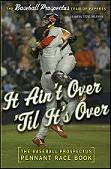Nice piece in the NY Times by Alan Schwarz, author of The Numbers Game, on Wins Relative to Average Player (WRAP). This stat was created by Brian Lonergan, a young economist from Yale, and Ben Polak his former dissertation adviser.
Essentially, this technique uses win expectancy tables to calculate the odds of winning before and after each of the 186,000 plate appearances and assigning responsibility to players involved in the play. Each player's contributions are then summed and a total number of wins they are responsible for calculated. The sum of all contributions for all players on the team equal the number of games the team is above .500.
This technique borrows heavily from the Mills Brothers Player Win Averages (PWA) methodology created in the late 1960s as well as Bennett and Flueck's Player Game Percentage (PGP) documented in chapter 10 of Curve Ball. The difference is that this system takes the next step and translates the probabilities into wins ala Bill James' Win Shares system.
Their results for 2004 include:
"A.L. M.V.P. Sheffield, with a 5.60 WRAP, edges out the Angels slugger Vladimir Guerrero (4.45). Ramirez ranks sixth because more of his hits came in game situations that did not have a big effect on the outcome of Boston games.
N.L. M.V.P. Bonds (12.16) tramples the runner-up, Albert Pujols of the Cardinals (6.85), demonstrating that Bonds's walks did indeed help the Giants by setting the table for subsequent, however disappointing, hitters.
A.L. CY YOUNG Despite having a higher E.R.A., Schilling tops Santana, 5.15 to 5.01, because he often performed in hitter-friendly Fenway Park (yes, WRAP accounts for this) and because he thrived in particularly tight situations. But the two were bested by Twins closer Joe Nathan (5.47), whose 1.62 E.R.A. and 44 saves do not truly quantify how many games his late pitching helped decide. (WRAP leans toward relievers because, although they influence fewer at-bats, the at-bats are inherently more crucial.)
N.L. CY YOUNG Once again, closers dominate, with the Dodgers' Eric Gagne (5.69) beating the Astros' Brad Lidge (5.55). San Francisco's Jason Schmidt (5.39) wins among starters, well ahead of the more popular candidates for postseason awards, Randy Johnson of Arizona and Roger Clemens of Houston."
Win Shares of course equate to one-third of a run and so comparing the 2004 Win Shares as calculated on The Hardball Times you get the following for those mentioned in the article (their winners bolded). WS=Win Shares, WSAA=Win Shares Above Average, Wins=WSAA/3 for comparison with WRAP.
WS WSAA Wins
Sheffield 31 15 5
Guerrero 29 12 4
Ramirez 28 12 4
Santana 27 15 5
Schilling 22 9 3
Bonds 53 37 12.3
Pujols 40 21 7
Rolen 38 21 7
Beltre 37 19 6.3
Abreu 37 18 6
Gagne 16 8 2.7
Lidge 17 9 3
Schmidt 19 8 2.7
Clemens 20 10 3.3
In evaluating the two systems it seems to me that WRAP overvalues closers because of the highly volatile situations in which they work (the danger of using situation-dependent measures like this) while Win Shares undervalues pitchers (Clemens was the highest rated pitcher in the NL and came in 33rd in total Win Shares behind Miguel Cabrera, Derek Lee, and Luis Castillo). Note, however, that Bonds, Pujols, Sheffield, Guerrero, and Santana were credited with a very similar number of wins in both systems.
You can also note that the ranges of both systems are similar and so generally you can say that MVP-type players may be worth an additional 5 to 8 wins (except for Bonds).
125x125_10off+copy.jpg)



No comments:
Post a Comment